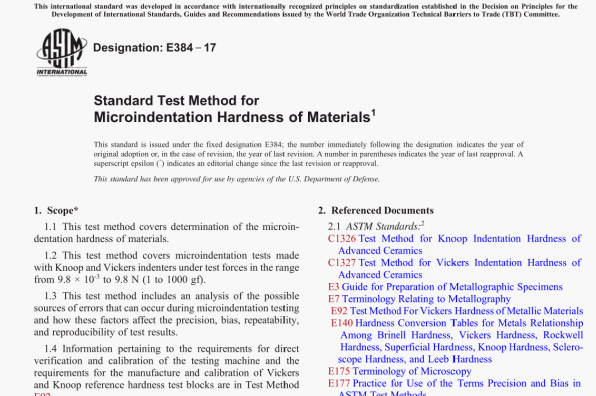ASTM E384:17 pdf download.Standard Test Method for Microindentation Hardness of Materials.
The necessary quality of the required surface preparation does vary with the forces and magnifications used in microindentation hardness testing. The lighter the force and the smaller the indentation size, the more critical is the surface preparation. Some materials are more sensitive to preparation-induced damage than others. In general, face-centered cubic metals (for example, austenitic stainless steels, copper and its alloys, nickel and its alloys, gold and silver) exhibit a larger deformation field around the indent than an indent of the same test force made in a body-centered cubic metal (for example, ferritic and martensitic steels).
7.1.3 Due to the small size of the indentations, special precautions must be taken during specimen preparation. It is well known that improper preparation can alter test results. Specimen preparation must remove any damage introduced during these steps, either due to excessive heating or cold work, for example.
7.1.4 Specimen preparation should be performed in accordance with Guide E3.
7.2 In many instances, it is necessary to mount the specimen for convenience in preparation and for best edge retention. When mounting is required, the specimen must be adequately supported by the mounting medium so that the specimen does not move during force application, such as might happen in an improperly cured polymer mount.
8. Procedure
8.1 Turn on the illumination system and power for the tester.
8.2 Select the desired indenter. If it is necessary to physically change indenters, refer to the manufacturer’s instructions. With some machines, both indenters can be mounted on the turret and changed by a simple switch or computer command. Occasionally clean the indenter with a cotton swab and alcohol. Avoid creating static charges during cleaning. Never touch the indenter tip with your fingers as this will alter the measurements.
8.3 Place the specimen on the stage or in the stage clamps. so that the specimen surface is perpendicular to the indenter axis. A top-referenced clamping system for mounts is an excellent device for aligning the test plane perpendicular to the indenter, particularly if the back face of the mount is not parallel to the polished front surface. If clay is used on a slide, use very stiff clay and use high pressure when seating the specimen against the clay.
84 Focus the measuring microscope with a low power objective so that the specimen surface can be observed.
8.5 Adjust the light intensity and adjust the apertures for optimum resolution and contrast. Zero the measuring device according to the manufacturer’s recommended method.
8.6 Select the area desired for hardness determination. Before applying the force, make a final focus using the measuring objective.
8.7 Adjust the tester so that the indenter is in the proper place for force application. Select the desired force.
ASTM E384:17 pdf download
